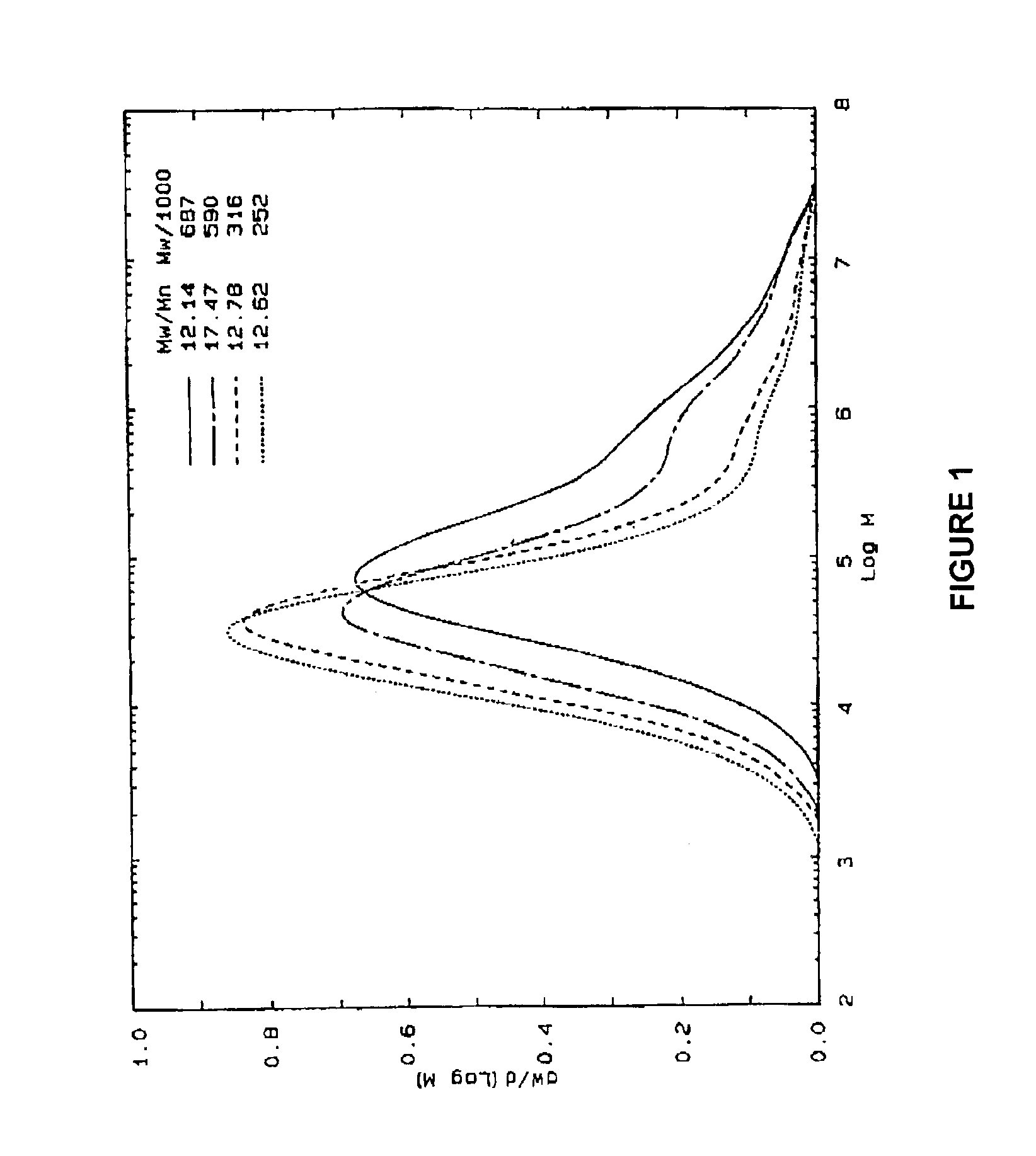Polymerization catalyst compositions and processes to produce polymers and bimodal polymers
a polymer and polymer technology, applied in the direction of catalyst activation/preparation, physical/chemical process, chemical/physical process, etc., can solve the problems of difficult filling of the requirements of the second metallocene, poor activity or stability, and narrow molecular weight distribution of metalocenes
- Summary
- Abstract
- Description
- Claims
- Application Information
AI Technical Summary
Problems solved by technology
Method used
Image
Examples
examples
Preparation of (CpTiCl2)2O:
[0082]Under a dry nitrogen atmosphere, 600 mL of dry tetrahydrofuran (THF) were added to a flask containing 64.70 grams of cyclopentadienyl titanium trichloride obtained from the Strem Company to produce a mixture. The mixture formed a first solution as the orange solid dissolved in the THF. Then, a second solution containing 200 mL of THF and 5.309 grams of water was added dropwise over a period of about 15 minutes while the first solution was stirred vigorously to produce a third solution. The color of the third solution turned slightly more reddish. The third solution then was heated gently to 40° C. and allowed to stand at that temperature for several hours. After standing at room temperature for an additional 24 hours, the THF then was evaporated under vacuum leaving a yellow-brown solid of (CpTiCl2)2O.
Preparation of the Chlorided, Zinc-Containing Alumina:
[0083]A commercial alumina sold as Ketjen grade B alumina was obtained from Akzo Nobel Chemical h...
examples 1-28
[0093]A number of bench-scale polymerization runs were made with (CpTiCl2)2O and with a number of other related titanium based organometal compounds for comparison. The results of these tests are listed in Table 1.
[0094]In these runs, usually 0.25 g of the chlorided, zinc-containing alumina described previously was charged to the reactor along with a few milligrams of the organometal compound, as indicated in the table, and a small amount of the organoaluminum compound, usually 1 mL or 0.5 mL of triisobutyl aluminum. In some cases, these ingredients were combined in a glass tube for a short time before being added to the reactor.
[0095]It can be seen from Table 1 that the inventive compound, designated as A in the table, is considerably more active than any other compound that was tested. Comparative compounds included the closest relative to the inventive compound, the cyclopentadienyl titanium dichloride aryloxides, and also the precursor material, cyclopentadienyl titanium trichlo...
examples 29-32
[0097]Bench scale polymerization runs were made at 80° C. with the inventive organometal compound A described previously and the chlorided, zinc-containing alumina. In each run, 1 mL of 1 molar triisobutylaluminum was added along with a varying amount of hexene. The polymers produced had a HLMI of zero. C-13 NMR branching analysis was performed on the polymers, and the following data in Table 2 were observed.
[0098]
TABLE 2GramsEthylButylHexeneBranchesBranchesExample No.AddedDensity (g / cc)Wt %Wt %29-Inventive100.93190.121.6230-Inventive200.93000.103.1831-Inventive300.92800.104.6232-Comparative1000.940101.02
[0099]Butyl branching increased, as expected, with increased hexene. The remarkable feature, however, is how much branching is incorporated with so little hexene added. This represents a high degree of comonomer incorporation efficiency. NMR detected ethyl branching as well, which indicates in-situ butene generation. In Comparison Example 32, bis (n-butylcyclopentadienyl) zirconium ...
PUM
| Property | Measurement | Unit |
|---|---|---|
| Temperature | aaaaa | aaaaa |
| Time | aaaaa | aaaaa |
| Pressure | aaaaa | aaaaa |
Abstract
Description
Claims
Application Information
 Login to View More
Login to View More - R&D
- Intellectual Property
- Life Sciences
- Materials
- Tech Scout
- Unparalleled Data Quality
- Higher Quality Content
- 60% Fewer Hallucinations
Browse by: Latest US Patents, China's latest patents, Technical Efficacy Thesaurus, Application Domain, Technology Topic, Popular Technical Reports.
© 2025 PatSnap. All rights reserved.Legal|Privacy policy|Modern Slavery Act Transparency Statement|Sitemap|About US| Contact US: help@patsnap.com

